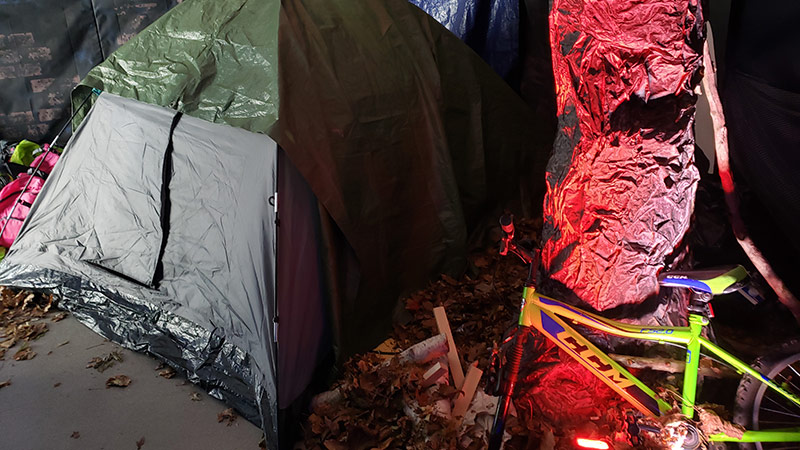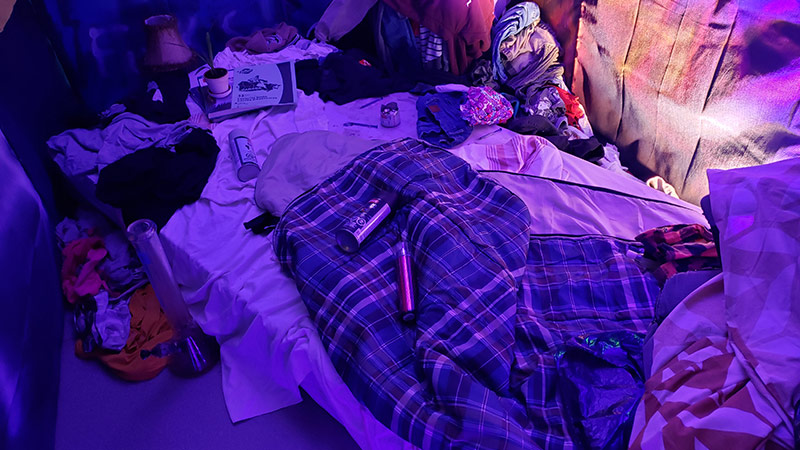'Building Home': Art meets advocacy in a journey through youth homelessness
Author: Tim Jaques
Posted on May 6, 2024
Category: UNB Saint John , UNB Fredericton

The first sight is familiar: a tent patched with duct tape, with a tarp thrown over it. A shopping cart contains bagged plastic bottles and a bicycle leans against a tree.
To the right is a mattress in what may be a jerry-built shack or an abandoned building, along with a backpack and someone's meagre possessions. A couch in an adjacent room serves as a bed.
Voices call out. Some express doubt, hopelessness and lack of self-worth. Others cast blame and judgment. From an office with a plexiglass divider between bureaucrat and client, robotic instructions issue from a government telephone voice-messaging system.
These nightmarish scenes comprise Building Home, an immersive art installation created by a collaboration that includes The Housing, Mobilization, Engagement and Resiliency Lab (HOME-RL) at the University of New Brunswick's (UNB) Saint John campus. It vividly depicts the harsh challenges and housing precariousness many New Brunswick youth face.
"Building Home started as a research project," said Cassandra Monette, director of youth-engaged research initiatives at HOME-RL, adding that the involvement of the Housing First For Youth (HF4Y) program led to one-on-one interviews with youth to understand how they managed housing crises.
"We looked at the themes across the interviews and paired with a group of artists to transform that information into something people can journey through," she said.
Monette said the youth were invited to review the themes to ensure accuracy.
"They were such a huge influence in all the elements that ended up in the installation," said Monette.
The result was this collaboration between HOME-RL and community organizations, artists and youth, initially shown in Saint John last November as part of National Housing Day. The Sheila Hugh Mackay Foundation provided the funding to bring the installation to the Beaverbrook.
The encampment and the shack interior show the visible homelessness seen in woods and fields within cities, while couch surfing is a form of homelessness not as well known to the public. The person in crisis moves from couch to couch at the homes of friends and relatives, hoping not to wear out their welcome.
Through its combination of visual and audio elements, Building Home demands that the viewer contemplate the complex issues surrounding youth housing insecurity. It offers a thought-provoking experience that extends beyond the gallery walls.
The last room in the installation may offer some hope or at least a goal. It is a regular—if messy—young person's bedroom. The entrance is carefully concealed, symbolizing the difficulty in finding housing where the youth can live with dignity, peace and security.

This room has no audio, but the voices of guilt and blame drift in from the other rooms, representing thoughts the youths struggle with and still need to work through.
"When the youth that were part of the project spoke to us about getting housing, they made it clear that's not the end of their journey," said Monette.
"It is just a step. It is an important step, a step that provides relief and safety, but it does not erase the experiences that they have accumulated while navigating being unhoused."
Creative workshops for youth were offered. Participants were given a tour of the installation, followed by reflection and the creation of collages to encourage a deeper understanding of youth homelessness. The collages will be shared in a virtual gallery on the Building Home website.
Speakers' nights offered explanations of the installation and youth homelessness, with the next on May 9 from 6 to 8 p.m.
Admission to the installation and the talks is free of charge and accessible through the doors of the Education Centre during the Beaverbrook's regular hours.
Building Home, which opened on April 30, closes in Fredericton on May 10 but will be exhibited again from May 15 to 17 at Market Square in Saint John at a housing conference hosted by the Human Development Council (HDC).
HOME-RL is a social science laboratory engaging in applied research and experiential education. It seeks solutions to housing and health inequities in Atlantic Canada and builds on UNB Saint John's core strengths of health, community and coastal studies.
Collaborators with HOME-RL in Building Home are the Saint John Arts Centre, Willow Youth Projects at the Teen Resource Centre, Pathways to Education, the Saint John Learning Exchange, Human Development Council, Greater Saint John Community Foundation, Habitat for Humanity, ConnecxionArc, Drive Marketing and Canada Mortgage and Housing Corporation (CMHC).
